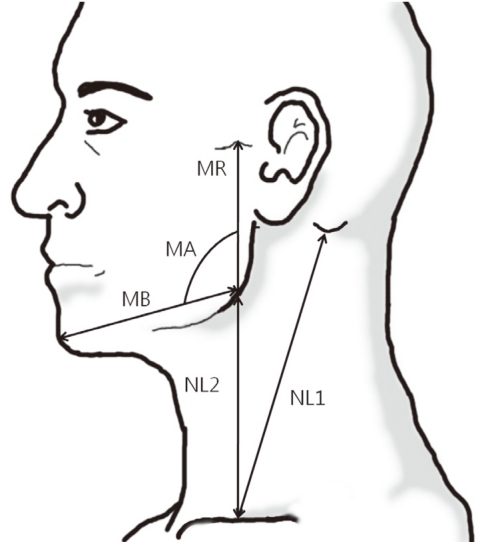Clin Exp Otorhinolaryngol.
2011 Mar;4(1):40-43.
Clinical Implications of Mandible and Neck Measurements in Non-Obese Asian Snorers: Ansan City General Population-Based Study
- Affiliations
-
- 1Department of Otorhinolaryngology-Head and Neck Surgery, Korea University College of Medicine, Seoul, Korea. shleeent@korea.ac.kr
- 2Department of Sleep Medicine, Shiga University of Medical Science, Shiga, Japan.
- 3Department of Dentistry, Korea University College of Medicine, Seoul, Korea.
- 4Institute of Human Genomic Study, Korea University College of Medicine, Seoul, Korea.
- 5Division of Pulmonary and Critical Care Medicine, Department of Internal Medicine, Korea University College of Medicine, Seoul, Korea.
Abstract
OBJECTIVES
Anthropometric abnormalities of the mandible and neck may contribute to snoring in non-obese Asians. The study evaluated the clinical implications of mandible and neck measurements in non-obese Asian snorers.
METHODS
The external mandible and neck measurements (neck circumference, two lengths of neck, mandibular body angle, and lengths of mandibular ramus and body) were compared between snorers and non-snorers in a sample of 2,778 non-obese Koreans (1,389 males, 1,389 females) aged 40 to 69 years (mean, 48.47+/-7.72 years).
RESULTS
The overall prevalence of snoring was 64.7% (899/1,389) and 48.3% (671/1,389) in non-obese male and female subjects, respectively. In non-obese males, snorers had significantly a greater neck circumference (P<0.0001) and shorter mandibular body length (P=0.0126) than non-snorers. In non-obese females, snorers had significantly greater neck circumferences (P=0.0165), compared with non-snorers. However, there were no statistically significant differences in other variables between non-snorers and snorers.
CONCLUSION
Anthropometric abnormalities of the mandible and neck, including thick neck circumference in both genders and small mandible size in males, may be relevant contributing factors to snoring in non-obese Asian snorers.
Keyword
Figure
Reference
-
1. Phillips B, Cook Y, Schmitt F, Berry D. Sleep apnea: prevalence of risk factors in a general population. South Med J. 1989; 9. 82(9):1090–1092. PMID: 2672353.2. Gislason T, Janson C, Tomasson K. Epidemiological aspects of snoring and hypertension. J Sleep Res. 1995; 6. 4(S1):145–149. PMID: 10607191.
Article3. Rauscher H, Popp W, Zwick H. Systemic hypertension in snorers with and without sleep apnea. Chest. 1992; 8. 102(2):367–371. PMID: 1643915.
Article4. Schmidt-Nowara WW, Coultas DB, Wiggins C, Skipper BE, Samet JM. Snoring in a Hispanic-American population. Risk factors and association with hypertension and other morbidity. Arch Intern Med. 1990; 3. 150(3):597–601. PMID: 2310278.
Article5. Lugaresi E, Cirignotta F, Coccagna G, Piana C. Some epidemiological data on snoring and cardiocirculatory disturbances. Sleep. 1980; 3(3-4):221–224. PMID: 7221330.
Article6. Jennum P, Hein HO, Suadicani P, Gyntelberg F. Risk of ischemic heart disease in self-reported snorers. A prospective study of 2,937 men aged 54 to 74 years: the Copenhagen Male Study. Chest. 1995; 7. 108(1):138–142. PMID: 7606948.7. Zaninelli A, Fariello R, Boni E, Corda L, Alicandri C, Grassi V. Snoring and risk of cardiovascular disease. Int J Cardiol. 1991; 9. 32(3):347–351. PMID: 1791087.
Article8. Neau JP, Meurice JC, Paquereau J, Chavagnat JJ, Ingrand P, Gil R. Habitual snoring as a risk factor for brain infarction. Acta Neurol Scand. 1995; 7. 92(1):63–68. PMID: 7572063.
Article9. Young T, Peppard PE, Taheri S. Excess weight and sleep-disordered breathing. J Appl Physiol. 2005; 10. 99(4):1592–1599. PMID: 16160020.
Article10. Namysłowski G, Scierski W, Mrowka-Kata K, Kawecka I, Kawecki D, Czecior E. Sleep study in patients with overweight and obesity. J Physiol Pharmacol. 2005; 12. 56(Suppl 6):59–65. PMID: 16340039.11. Fogel RB, Malhotra A, White DP. Sleep. 2: pathophysiology of obstructive sleep apnoea/hypopnoea syndrome. Thorax. 2004; 2. 59(2):159–163. PMID: 14760159.12. Sakakibara H, Tong M, Matsushita K, Hirata M, Konishi Y, Suetsugu S. Cephalometric abnormalities in non-obese and obese patients with obstructive sleep apnoea. Eur Respir J. 1999; 2. 13(2):403–410. PMID: 10065689.
Article13. Ong KC, Clerk AA. Comparison of the severity of sleep-disordered breathing in Asian and Caucasian patients seen at a sleep disorders center. Respir Med. 1998; 6. 92(6):843–848. PMID: 9850368.
Article14. Li KK, Kushida C, Powell NB, Riley RW, Guilleminault C. Obstructive sleep apnea syndrome: a comparison between Far-East Asian and white men. Laryngoscope. 2000; 10. 110(10 Pt 1):1689–1693. PMID: 11037826.
Article15. Kim J, In K, Kim J, You S, Kang K, Shim J, et al. Prevalence of sleep-disordered breathing in middle-aged Korean men and women. Am J Respir Crit Care Med. 2004; 11. 15. 170(10):1108–1113. PMID: 15347562.
Article16. Andersson L, Brattstrom V. Cephalometric analysis of permanently snoring patients with and without obstructive sleep apnea syndrome. Int J Oral Maxillofac Surg. 1991; 6. 20(3):159–162. PMID: 1890323.
Article17. Lam B, Ip MS, Tench E, Ryan CF. Craniofacial profile in Asian and white subjects with obstructive sleep apnoea. Thorax. 2005; 6. 60(6):504–510. PMID: 15923252.
Article18. Ferguson KA, Ono T, Lowe AA, Ryan CF, Fleetham JA. The relationship between obesity and craniofacial structure in obstructive sleep apnea. Chest. 1995; 8. 108(2):375–381. PMID: 7634870.
Article19. Shelton KE, Gay SB, Hollowell DE, Woodson H, Suratt PM. Mandible enclosure of upper airway and weight in obstructive sleep apnea. Am Rev Respir Dis. 1993; 7. 148(1):195–200. PMID: 8317798.
Article20. Miles PG, Vig PS, Weyant RJ, Forrest TD, Rockette HE Jr. Craniofacial structure and obstructive sleep apnea syndrome: a qualitative analysis and meta-analysis of the literature. Am J Orthod Dentofacial Orthop. 1996; 2. 109(2):163–172. PMID: 8638562.
- Full Text Links
- Actions
-
Cited
- CITED
-
- Close
- Share
- Similar articles
-
- The Relationship between Snoring Noise and Hearing Impairment in Snorers and Their Spouses
- Cephalometric differences in obstructive sleep apnea between obese and non-obese Korean male patients
- Clinical Review of Commercially-Available Anti-Snoring Devices
- Comprehensive Comparison between Snoring and Non-Snoring Children
- Does the Oropharyngeal Fat Tissue Influence the Oropharyngeal Airway in Snorers? Dynamic CT Study


